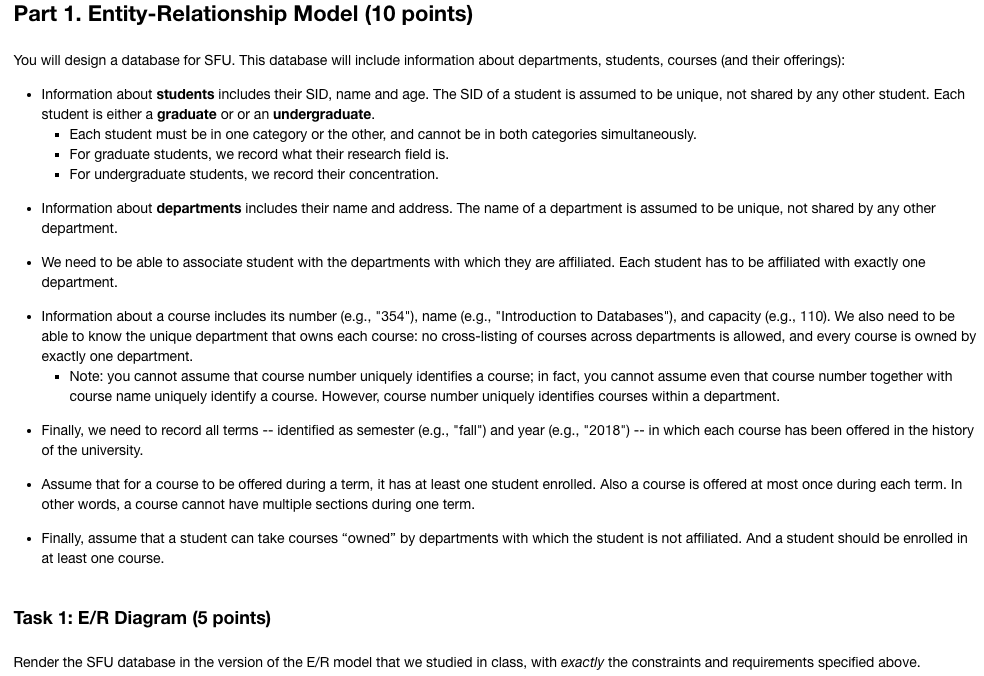
Part 1. Entity-Relationship Model (10 points) You will design a database for SFU. This database will include information about departments, students, courses (and their offerings): Information about students includes their SID, name and age. The SID of a student is assumed to be unique, not shared by any other student. Each student is either a graduate or or an undergraduate Each student must be in one category or the other, and cannot be in both categories simultaneously. - For graduate students, we record what their research field is For undergraduate students, we record their concentration. Information about departments includes their name and address. The name of a department is assumed to be unique, not shared by any other department. We need to be able to associate student with the departments with which they are affiliated. Each student has to be affiliated with exactly one department. . Information about a course includes its number (e.g., "354"), name (e.g., "Introduction to Databases"), and capacity (e.g., 110). We also need to be able to know the unique department that owns each course: no cross-listing of courses across departments is allowed, and every course is owned by exactly one department. Note: you cannot assume that course number uniquely identifies a course; in fact, you cannot assume even that course number together with course name uniquely identify a course. However, course number uniquely identifies courses within a department. Finally, we need to record all terms -identified as semester (e.g., "fall") and year (e.g., "2018") - in which each course has been offered in the history of the university. . Assume that for a course to be offered during a term, it has at least one student enrolled. Also a course is offered at most once during each term. In other words, a course cannot have multiple sections during one term. Finally, assume that a student can take courses "owned" by departments with which the student is not affiliated. And a student should be enrolled in at least one course. Task 1: E/R Diagram (5 points) Render the SFU database in the version of the E/R model that we studied in class, with exactly the constraints and requirements specified above. Part 1. Entity-Relationship Model (10 points) You will design a database for SFU. This database will include information about departments, students, courses (and their offerings): Information about students includes their SID, name and age. The SID of a student is assumed to be unique, not shared by any other student. Each student is either a graduate or or an undergraduate Each student must be in one category or the other, and cannot be in both categories simultaneously. - For graduate students, we record what their research field is For undergraduate students, we record their concentration. Information about departments includes their name and address. The name of a department is assumed to be unique, not shared by any other department. We need to be able to associate student with the departments with which they are affiliated. Each student has to be affiliated with exactly one department. . Information about a course includes its number (e.g., "354"), name (e.g., "Introduction to Databases"), and capacity (e.g., 110). We also need to be able to know the unique department that owns each course: no cross-listing of courses across departments is allowed, and every course is owned by exactly one department. Note: you cannot assume that course number uniquely identifies a course; in fact, you cannot assume even that course number together with course name uniquely identify a course. However, course number uniquely identifies courses within a department. Finally, we need to record all terms -identified as semester (e.g., "fall") and year (e.g., "2018") - in which each course has been offered in the history of the university. . Assume that for a course to be offered during a term, it has at least one student enrolled. Also a course is offered at most once during each term. In other words, a course cannot have multiple sections during one term. Finally, assume that a student can take courses "owned" by departments with which the student is not affiliated. And a student should be enrolled in at least one course. Task 1: E/R Diagram (5 points) Render the SFU database in the version of the E/R model that we studied in class, with exactly the constraints and requirements specified above







